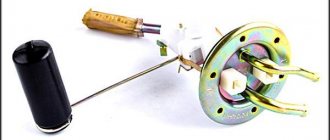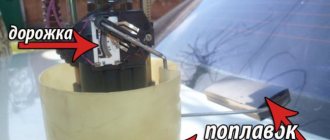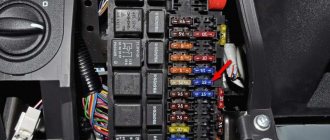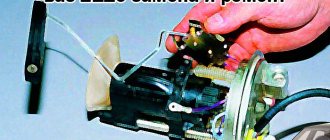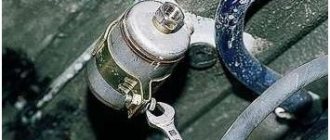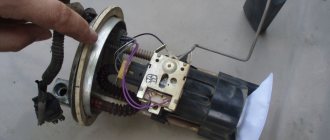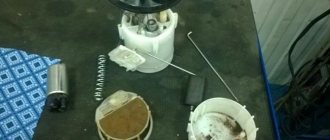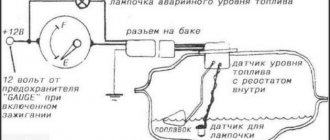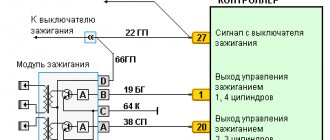Diagnostic mode for Largus tidy
so here it is for: To enter the diagnostic mode, you need to insert the key into the ignition switch, press the pin on the instrument panel, and without releasing it, turn the key to the ignition position, while holding the pin for several seconds until the numbers appear on the screen, after which it need to let go. The existing mode has four windows with information that appear one after another when you briefly press the pin:
1. the first screen shows the firmware version of the on-board computer;
2. The second screen diagnoses the performance of all elements of the LCD display, turning them all on at the same time. In the event of a malfunction, one of the elements will not light up. I note that one of the elements on the left of the clock display is missing for all cars, because... for both types of time indications (12-hour and 24-hour) this element is not used;
3. The third screen shows the remaining fuel in the tank accurate to the nearest liter and provides more accurate information than the standard graphic bar. If there is an open circuit or short circuit fault, the display shows “- — -“. It is important to note that the fuel level sensor located in the gas tank does not reflect the amount of fuel filled above the 50 liter limit. Those. if you filled the gas tank with 51 or more liters, then the BC in diagnostic mode will still show only 50 liters;
5. The fifth screen informs about the presence or absence of malfunctions of the coolant level sensors, fuel level sensor and fuel consumption information system. If there are no existing or stored faults, the display shows “- — — — -“. – Stored and existing malfunctions of the coolant temperature sensor are displayed in the form “- — -TO” when the circuit is open, “- — -TC” when the circuit is short-circuited. Coolant temperature sensor malfunctions are not critical; You can ignore the “TO” fault if the engine is cold. – Stored and existing faults of the fuel level sensor are displayed in the form “-JO- -” when the circuit is open, “-JC- -” when there is a short circuit. – Stored and existing malfunctions of the fuel consumption information system are displayed as “D- — — -” in the absence of a fuel consumption signal. Malfunctions of the fuel consumption information system are only taken into account if the vehicle is equipped with an on-board computer. All “stored sensor faults” listed on the page are faults that were detected but no longer appear. If there are several stored or existing faults, they are shown on the same line.
To delete stored faults from the memory and exit the self-diagnosis mode, press and hold the pin pressed for several seconds;
aerodynamics
We crawl, hobble in the darkness...
How to get to the gas station? Close the windows to improve aerodynamics and turn off the air conditioning if possible (air conditioning is a serious energy consumer). There's no point in turning off the music; she won't eat much. Leave the headlights on too - otherwise you will save on safety, which you cannot do, no matter what happens. You need to move as evenly as possible, without sudden acceleration and braking, in top gear, at a speed of about 80 km/h (not in populated areas). In 2008, our editor traveled to St. Petersburg and back on one tank, driving a 170-horsepower Volvo.
How to check the remaining gasoline on a Largus?
Turn off the ignition and press the daily mileage reset button. Without releasing the button, turn on the ignition (do not start the engine). After a second, the instrument panel will go into test mode. This way you can see at how many liters the light comes on.
How to find out how much gasoline is left?
Formula for calculating fuel consumption
The formula is quite simple: the amount of fuel that you refueled for the second time must be divided by the number of kilometers and multiplied by 100. The resulting figure indicates how much gasoline or diesel is required to cover 100 km.
How to find out how much gasoline is in the Renault Logan 2 tank?
You need to hold the button pressed until a combination of numbers appears on the display. At the same time, the odometer and tachometer needles will begin to move chaotically - this is normal. Using the same button, we scroll through the on-board computer readings until it shows the remaining fuel in the tank in liters.
How many kilometers can you drive with a light bulb on?
Well, on average, the following values are obtained: -passenger cars, after the fuel level light in the tank lights up, can still travel about 50 kilometers, while SUVs and crossovers, which have an increased volume of fuel tanks, can drive about 150 kilometers with the fuel light on. kilometers.
How much gasoline is in the tank when the light on the VAZ 2107 is on?
For classic VAZ 2101-2107 cars, when the fuel level light comes on, approximately 6-8 liters of gasoline remain in the tank, provided that the fuel float is working properly.
How many liters is the gas tank for Renault Logan?
Knowing the average fuel consumption, you can easily calculate how many kilometers a full tank of fuel will last you. On-board computers of modern cars are able to quickly show this information to the driver. The volume of the Renault Logan fuel tank is 50 liters.
How long will Logan travel with a light bulb?
The fuel level lamp lights up on Renault Logan when the remaining gasoline in the tank is 5 liters. Thus, with a normal driving style in a mixed cycle, with the light on, you can drive about 50 km more.
How to check if the fuel level sensor is working?
If the instrument on the panel is working properly, the arrow will show a full tank. This means the fuel level sensor is not working. If there are 2 wires coming to the gas tank, connect them alternately to the vehicle ground. From one the control lamp should light up, from the second the pointer should move to maximum.
How many liters of gasoline per 1 km?
That is, on one liter we can travel approximately 12 kilometers. Accordingly, this value multiplied by the volume of the tank will tell us how far we can travel on a full tank of gasoline - 12 * 60 = 720 km.
Why is the fuel level sensor lying?
How many liters is one division on the Duster?
On-board computers of modern cars are able to quickly show this information to the driver. The volume of the Renault Duster fuel tank is 50 liters.
How many liters of gasoline are in the tank?
The fuel tank capacity of passenger cars varies from 45 liters for small cars to 100 liters for large SUVs. On average, the standard declared volume is 50-55 liters.
refilling gasoline
Meanwhile, “drying out” is bad: you can find a lot of unpleasant adventures both for yourself and for the car. For example, burn out a fuel pump that will not have enough cooling. In addition, it will begin to pick up dirt that is in the tank of any car with high mileage. A lean mixture may damage the catalytic converter. When the engine is running at high speeds and the fuel mixture stops flowing into it (for example, in a long turn), this can lead to detonation and subsequent repairs. If it happens in a mountainous area, there is a risk of not being able to overcome the climb. And in general, any forced stop far from civilization is unsafe. In winter, you can simply freeze, afraid to leave the car. Do you think it's fiction? Alas, this happens. And not only in Siberia and the Far East, but even in central Russia. By the way, read in your spare time how to survive in this case.
How to check the remaining fuel in Lada Largus?
Fuel consumption of Lada Largus ranges from 7.6 to 8.2 liters per 100 km. Lada Largus is available with the following fuel types: Gasoline AI-92, Gasoline AI-95, Gas/petrol.
How many liters are in the Largus tank?
Knowing the average fuel consumption, you can easily calculate how many kilometers a full tank of fuel will last you. On-board computers of modern cars are able to quickly show this information to the driver. The fuel tank volume of the Lada Largus is 50 liters.
How many liters is in Renault Logan?
Knowing the average fuel consumption, you can easily calculate how many kilometers a full tank of fuel will last you. On-board computers of modern cars are able to quickly show this information to the driver. The volume of the Renault Logan fuel tank is 50 liters.
How much gasoline fits into a Renault Logan tank?
The passport states that the fuel tank holds 50 liters of gasoline.
How to measure the remaining fuel in the tank?
Usually the measurement is done almost blindly. An experienced measurer (and there are such at every car company), poking a stick into the bottom of the tank, pulls it out into the light of day and looks at the marks. From them he can roughly determine how much fuel is in the tank.
How many liters of gasoline per 1 km?
How to check if the fuel level sensor is working?
- Turn on the multimeter in resistance measurement mode.
- We connect probes to the sensor terminals and move the resistive lever along the track.
What kind of gasoline should I put in Lada Vesta?
How far can you drive a Largus light bulb?
operating instructions Make, model Fuel reserve, as indicated in the operating manual Notes Lada Largus Similar Similar to Renault Sandero “From the moment the warning light first comes on, you can drive another 50 km.” In fact, the reserve in the tank is at least 5 liters, possibly 7. Another 14 lines
How to drain gasoline from a Largus tank?
The second method will require access from below the car. Under the right rear wheel there is a fuel filter (not available on all trim levels). It is necessary to unscrew the fuel supply pipe, replacing the container first, and turn the ignition to position 2 so that the fuel pump turns on, which pumps gasoline out of the tank.
Why you shouldn’t delay refueling
Unless you find yourself on a desert island where there are no gas stations at all, then most likely you will have enough fuel. But does this mean that refueling is okay? No and no again.
If you are driving in an unfamiliar area, how do you know when the next gas station will be? So, turn to the first one you come across and fill in more. Remember that you will still have to fork out money. Only if you stop halfway and one of the drivers passing by agrees to take you in tow or drive you for a bottle of gasoline, “refueling” will cost more.
This happened to me once: night, an unfamiliar city, a burning light bulb... I still hope for an opportunity that will suddenly lead me to some gas station. But in vain. The car stops, it’s good that I have time to roll back to the curb. A belated motorist comes to the rescue, and twenty minutes later he brings me a plastic bottle (wow, he managed to pour fuel into an “unregulated” container). I pay for gasoline and, although quite moderately, for services. I consider myself lucky.
Fuel level indicator
To enter the diagnostic mode, you need to insert the key into the ignition switch, press the pin on the instrument panel, and without releasing it, turn the key to the ignition position, while holding the pin for several seconds until the numbers appear on the screen, after which it must be released. The existing mode has four windows with information that appear one after another when you briefly press the pin:
1. the first screen shows the firmware version of the on-board computer;
2. The second screen diagnoses the performance of all elements of the LCD display, turning them all on at the same time. In the event of a malfunction, one of the elements will not light up. I note that one of the elements on the left of the clock display is missing for all cars, because... for both types of time indications (12-hour and 24-hour) this element is not used;
3. The third screen shows the remaining fuel in the tank accurate to the nearest liter and provides more accurate information than the standard graphic bar. If there is an open circuit or short circuit fault, the display shows “- — -“. It is important to note that the fuel level sensor located in the gas tank does not reflect the amount of fuel filled above the 50 liter limit. Those. if you filled the gas tank with 51 or more liters, then the BC in diagnostic mode will still show only 50 liters;
4. The fourth screen informs about the presence or absence of malfunctions of the coolant level sensors, fuel level sensor and fuel consumption information system (only if the car has a BC with firmware 6002). If there are no existing or stored faults, the display shows “- — — — -“. – Stored and existing malfunctions of the coolant temperature sensor are displayed in the form “- — -TO” when the circuit is open, “- — -TC” when the circuit is short-circuited. Coolant temperature sensor malfunctions are not critical; You can ignore the “TO” fault if the engine is cold. – Stored and existing faults of the fuel level sensor are displayed in the form “-JO- -” when the circuit is open, “-JC- -” when there is a short circuit. – Stored and existing malfunctions of the fuel consumption information system are displayed as “D- — — -” in the absence of a fuel consumption signal. Malfunctions of the fuel consumption information system are only taken into account if the vehicle is equipped with an on-board computer. All “stored sensor faults” listed on the page are faults that were detected but no longer appear. If there are several stored or existing faults, they are shown on the same line.
To delete stored faults from the memory and exit the self-diagnosis mode, press and hold the pin pressed for several seconds;
Replacing the absolute pressure sensor
The absolute pressure (vacuum) sensor is installed on the inlet pipe.
The sensor records changes in pressure (vacuum) in the intake pipe depending on changes in load and engine speed and converts them into an output signal voltage. Depending on the sensor signal, the ECU calculates the amount of air entering the engine. And on VAZ engines the absolute pressure sensor is combined with an intake air temperature sensor. Absolute pressure sensor
Links to pictures with the location of the sensors and their catalog numbers depending on the engine model: For the K7M engine For the K4M engine For the VAZ-11189, 21129 engine
The inlet pipes of VAZ engines, as well as K7M and K4M, have different designs and locations. In this regard, replacing the absolute pressure sensor on these engines is described separately.
On K4M engines
The sensor is installed in the receiver on the right.
...disconnect the ECM wiring connector from the sensor.
After overcoming the resistance of the rubber seals, remove the sensor from the hole in the receiver.
The sensor is sealed with two rubber rings. If there are cracks, tears, or loss of elasticity on the O-rings, replace the seals
Installation is carried out in reverse order.
On K7M engine
The DBP sensor is installed in the intake manifold on the left.
Using a screwdriver, press out the connector lock...
. and disconnect the ECM wiring connector from the pressure sensor.
Using two screwdrivers, carefully remove the sensor from the hole in the intake manifold (for clarity, shown on the removed intake manifold)
The sensor is sealed with two rubber rings. (see photo above). Replace rings if necessary.
On VAZ engines (shown on 21129)
On a VAZ engine, absolute pressure sensor 1 is installed on intake module 2 . It includes an intake air temperature sensor, so its full name is an air pressure and temperature sensor (APTD)
Disconnect the “-” terminal of the battery.
By pressing the latch 1 , disconnect the wiring harness block from the sensor.
Inspect the connector and make sure there is no damage or oxide on its terminals. If necessary, clean the terminals and treat them with a special product for electrical contacts.
Using a Phillips screwdriver, unscrew fastening screw 2 and, overcoming the resistance of the rubber seal, remove the sensor.
The connection is sealed with rubber rings, which, if they become obsolete, must be replaced.
Install the sensor in reverse order. Before installation, apply a thin layer of silicone grease to the O-ring.
Video
Source
How to find out the remaining fuel on Largus?
The formula is quite simple: the amount of fuel that you refueled for the second time must be divided by the number of kilometers and multiplied by 100. The resulting figure indicates how much gasoline or diesel is required to cover 100 km. For example, the second time you filled the car with 47.6 liters, and before that you drove 525 km.
How is Largus cross different from regular cross?
The Cross version is slightly higher than the base model, has unpainted bumpers with gray inserts and additional black trim on the wheel arches and sills. Disks. The off-road version is equipped with 16-inch wheels, while the base version has 15-inch wheels.
How many liters are in the Largus tank?
Knowing the average fuel consumption, you can easily calculate how many kilometers a full tank of fuel will last you. On-board computers of modern cars are able to quickly show this information to the driver. The fuel tank volume of the Lada Largus is 50 liters.
How to find out how much gasoline is in the Renault Logan 2 tank?
You need to hold the button pressed until a combination of numbers appears on the display. At the same time, the odometer and tachometer needles will begin to move chaotically - this is normal. Using the same button, we scroll through the on-board computer readings until it shows the remaining fuel in the tank in liters.
How to check if the fuel level sensor is working?
Remove the positive terminal and short it to ground. If the instrument on the panel is working properly, the arrow will show a full tank. This means the fuel level sensor is not working. If there are 2 wires coming to the gas tank, connect them alternately to the vehicle ground.
How many liters of gasoline are in the tank?
The fuel tank capacity of passenger cars varies from 45 liters for small cars to 100 liters for large SUVs. On average, the standard declared volume is 50-55 liters.
What is the difference between Largus Cross and a station wagon?
How can you raise Largus?
- Installation of larger diameter wheels and higher tires.
- Installation of special spacers.
- Installation of larger shock absorbers and springs.
How much does a Lada Largus van cost?
LADA Largus van from RUB 704,900. – Prices and configurations – Official LADA website.
How many cubes fit in Largus?
| Body | ||
| Working volume, cubic meters cm | 1596 | |
| Maximum power, kW (hp) / rev. min. | 64 (87) / 5100 | 78 (106) / 5800 |
| Maximum torque, Nm / rev. min. | 140 / 3800 | 148 / 4200 |
| Fuel | gasoline, min 92 | |
How much does a Largus van weigh?
But with height, not everything is so simple: it is measured from the ground to the roof of the car; The height of the roof rails is not included in the overall height of the body. Overall dimensions of Lada Largus are from 4470 x 1750 x 1636 to 4840 x 1750 x 2000 mm, and weight is from 1260 to 1380 kg.
How to see liters in Logan?
Turn off the ignition and press the daily mileage reset button. Without releasing the button, turn on the ignition (do not start the engine). After a second, the instrument panel will go into test mode. This way you can see at how many liters the light comes on.
How long can you drive with a Renault Logan light on?
The fuel level lamp lights up on Renault Logan when the remaining gasoline in the tank is 5 liters. Thus, with a normal driving style in a mixed cycle, with the light on, you can drive about 50 km more.
Cruise control
To maintain a certain speed, cruise control was invented in the middle of the last century, also known as tempomat, which most cars have today. Cars with new automatic transmissions are, in principle, more economical than cars with manual transmissions - they change gears according to a certain algorithm, and not at random, and are trained primarily to conserve fuel. But even modern cars with manual transmissions (for example, Lada Vesta) have built-in “gear shift prompts” (AvtoVAZ term). And even ancient Zhiguli cars have an econometer that suggests the optimal driving mode. And in the latest generation of foreign cars, as a rule, you can select the appropriate operating mode of the power unit by pressing the Eco button. Use the maximum of available tools. If you can, check the tire pressure and adjust it to the specified pressure (the information can be found on the back of the gas filler flap or on a sign in the doorway). Are you traveling with a box on the roof and a trailer on the tail? To get to the gas station, get rid of both and pick them up when you have enough fuel.
But in general, we wish you never to see the fuel reserve light on, always fill the tank under the cap, and if you sometimes go out of town, keep at least a five-liter canister with a built-in watering can in the trunk. It is inexpensive, 500 rubles, and does not take up much space. If it closes tightly, hermetically, it doesn’t even smell. We do not recommend carrying plastic bottles with gasoline: they are more dangerous than cans. And the car burns to the ground in a couple of minutes.
One last thing: instruction manuals are interesting reading. I recommend it.
Your question: How can I see how many liters are in the Largus tank?
Turn off the ignition and press the daily mileage reset button. Without releasing the button, turn on the ignition (do not start the engine). After a second, the instrument panel will go into test mode. This way you can see at how many liters the light comes on.
How far can you drive a Largus light bulb?
How to find out how many liters of gasoline are in the tank?
How to measure how many liters of fuel are in the tank?
- Start the car and time how long it takes for it to stall, knowing the fuel consumption for such a case.
- Drive the car and see after how many kilometers it stalls, knowing the consumption per km.
- Drain the gasoline and measure manually.
- Weigh the car, which only contains gasoline, and compare it with the weight of the empty car in the passport.
How many liters are in the Largus tank?
Knowing the average fuel consumption, you can easily calculate how many kilometers a full tank of fuel will last you. On-board computers of modern cars are able to quickly show this information to the driver. The fuel tank volume of the Lada Largus is 50 liters.
How to find out how much gasoline is in the Renault Sandero tank?
How many liters are in one division on Renault Logan?
On Renault Sandero and Logan cars (as well as Duster), the on-board computer is installed only in the Privilege configuration. The fuel scale only shows the approximate number of liters of fuel in the tank. By default, each division is 5 liters.
How many kilometers can you drive with a Renault Logan light bulb?
The fuel level lamp lights up on Renault Logan when the remaining gasoline in the tank is 5 liters. Thus, with a normal driving style in a mixed cycle, with the light on, you can drive about 50 km more.
How much gasoline does it consume per 100 km?
How many kilometers can you drive with a light bulb on?
Well, on average, the following values are obtained: -passenger cars, after the fuel level light in the tank lights up, can still travel about 50 kilometers, while SUVs and crossovers, which have an increased volume of fuel tanks, can drive about 150 kilometers with the fuel light on. kilometers.
How much gasoline is in the tank when the light on the VAZ 2107 is on?
For classic VAZ 2101-2107 cars, when the fuel level light comes on, approximately 6-8 liters of gasoline remain in the tank, provided that the fuel float is working properly.
How much gasoline remains in the tank when the light on the VAZ 2106 comes on?
How to calculate how much gasoline is left?
The formula is quite simple: the amount of fuel that you refueled for the second time must be divided by the number of kilometers and multiplied by 100. The resulting figure indicates how much gasoline or diesel is required to cover 100 km. For example, the second time you filled the car with 47.6 liters, and before that you drove 525 km.
How to calculate the volume of a tank knowing its dimensions?
We measure the depth of the tank, height and width in centimeters. For example, we got the following parameters: depth – 50 cm, height – 60 cm and width – 100 cm. According to these dimensions, the volume of the aquarium is calculated by the formula (V=X*Y*H) or 100x50x60=3000000 cm³.
How many liters of gasoline per 1 km?
The calculation formula used by consumption calculators is very simple: divide the displacement by the kilometer and multiply by one hundred - l/km * 100.
eco mode
Stop panicking!
As you can see, in order to find the answer to the question of how long and how far you can drive “with a light bulb,” I studied the operating instructions for the most popular cars in Russia. The data was compiled into a table. Conclusion: the minimum fuel supply that car manufacturers provide us is 5 liters, in most cases it is about 7 liters. This should be enough for at least 90 kilometers when driving on a country road in a B-class car. So there is no need to panic when you see a low fuel light or a written warning that the tank is almost empty - unless, of course, you are in the tundra or desert. You'll make it to the gas station.
To find out where the nearest one is, look at the navigator map by turning on POI and filtering by gas station. No navigator - stop to use your smartphone or tablet. A short stop won't hurt. Of course, it is better to find a network gas station with high-quality gasoline, but if there is no guarantee that one is nearby, it is better not to risk it and refuel at the first one - minimally. When you reach a decent level, fill the tank full and dilute fuel of dubious quality. And wait a couple of seconds after turning on the ignition before starting the engine: let the pump fill with normal gasoline.
How to check fuel consumption on a Largus
There is no car enthusiast who would not be concerned about the fuel consumption of his car. A psychologically important mark is the value of 10 liters per hundred. If the consumption is less than ten liters, then this is considered good, but if it is higher, then it requires explanation. In the last few years, fuel consumption of about 6 liters per 100 km has been considered optimal in terms of economy.
Fuel consumption of Lada Largus ranges from 7.6 to 8.2 liters per 100 km.
Lada Largus is available with the following fuel types: Gasoline AI-95, Gasoline AI-92, Gas/petrol.
The manufacturer notes that fuel consumption data was determined under standardized conditions using special measuring equipment, in accordance with the requirements of GOST R41.101–99 (UNECE Rules No. 101). Used to compare cars from different automakers. They are not an operational standard.
High fuel consumption of Lada Largus? Here's why this might happen:
- In winter, there is an increased consumption of gasoline.
- Active driving style, frequent acceleration and braking.
- According to the results of another study, it was found that when using AI95 gasoline, fuel consumption decreases slightly.
- Using air conditioning and other additional electrical equipment of the car. For example, when the air conditioner is running, fuel consumption increases by 1 l/100 km.
- Malfunction of the engine or its systems.
- Other reasons.
Take part in the survey below, the purpose of which is to determine the combined fuel consumption of the Lada Largus.
The LADA Largus car is primarily appreciated by consumers not only for its resemblance to Logan and its cheap price. Owners of this model claim that the fuel consumption of the Lada Largus is quite economical and the technical characteristics are at a sufficient level. Fuel consumption measurements were taken under municipal conditions and while traveling on a highway outside the city.
More about this.
LADA Largus car in a car showroom
Municipal travel mode
The technical documentation for the Lada Largus car, which is equipped with a 16-valve engine with a capacity of 1.6 liters, states that when driving in a populated area, gasoline consumption should be on average 12.4 liters. What is the municipal regime? These are conditions for moving a vehicle under which you have to be in traffic jams, drive slowly in a whole stream of cars, be at traffic lights and maneuver at intersections.
With this driving mode, of course, more gasoline is consumed than when moving outside the city.
The driver, who decided to check compliance with the amount of fuel specified in the documentation, went to the city in a LADA Largus with a mileage of 1197. In other words, the car is still going through the running-in process. Based on this steam, higher gasoline consumption is acceptable.
The tester got stuck in major traffic jams and his air conditioning was working all the time. Under such driving conditions, the fuel consumption turned out to be 13.3 liters. a fairly acceptable figure for the Largus break-in time. If you go out on the road at times of minimal congestion on municipal streets, and have a smooth driving style, then it is possible to reduce the amount of fuel used, sometimes up to 2 liters. Those drivers who are accustomed to driving with rapid braking and acceleration are unlikely to be able to count on reducing fuel consumption.
Fuel consumption in municipal mode is on average 12-13 liters
Moving outside the city
To determine the amount of fuel used outside the city, the tester chose a highway with small
Video review of the Lada Largus, including fuel consumption:
The average speed during the trip was 76.9 km/h. Fuel consumption turned out to be 7.2 liters per 100 km. And this is when using 95 gasoline, which is recommended by the manufacturer.
While driving on the highway, the LADA Largus did not travel at the same speed. There was acceleration, braking and overtaking. The speed range was from 80 to 120 km/h.
And along with this, consumption turned out to be less than indicated in the technical documentation. While ahead of cars, Largus behaves with confidence. In fifth gear, the car accelerates superbly from 90 to 120.
At the time when the speed reaches 120, the engine speed is 4000 rpm. The cabin is quite noisy. If you reduce the speed to 90 km/h (3200 rpm), the noise actually becomes less. But the best speed for a car is 100-105.
This is beneficial because the use of fuel is the most economical and the noise is moderate.
Fuel consumption on the highway averages 7-8 liters
It is possible to conclude that the Lada Largus is also quite an economical car during the run-in. In municipal travel mode, consumption is very slightly higher than that specified by the manufacturer, and outside the city on the highway the car also used less than what is indicated in the technical documentation for the vehicle.
Lada Largus fuel consumption
Similar articles that you will probably be interested in:
How to achieve optimal fuel consumption for a Volga?
MashinaPRO » Auto reviews » How to achieve optimal fuel consumption in the Volga? Categories Popular Debriefing, or Adjusting the carburetor unit…
How do they affect a car's fuel consumption?
air conditioning, lights, heater, music, heating, etc. How does an air conditioner change a car's fuel consumption? Turning on the air conditioner increases fuel consumption...
Modern injection engines have replaced the carburetor for several reasons, but the most basic of them is, of course, more...
How to find out gas consumption for heating a house?
There are a couple of ways to heat a house. It can be coal, firewood or liquid fuel. But now the heating method is becoming more and more widespread...
High fuel consumption of the VAZ 2114 - a story about how simple things save car lives
VAZ 2114, or Lada Samara-2, or Lada 114 is a domestic car recognizable to many, which is a five-door B-class hatchback. Available...
Lacetti fuel consumption
Perhaps the most pressing topic for Chevrolet Lacetti owners is fuel consumption. Consumption and in fact also for a 1.4 liter engine...
The secret of increased performance
Currently, manufacturers of Lada Largus cars indicate in the technical documentation attached to it the dimensions of their fuel tank, equal to approximately 50 liters. In fact, you can put a lot more gasoline into it. There are several reasons for this:
- relatively large fuel tank neck;
- deliberate application of a slightly smaller volume by manufacturers to comply with technical documentation;
- the presence of special voids in the tank that increase its level of wear resistance;
- errors in the operation of refueling equipment.
About the long neck
Naturally, the creators of the Lada Largus car, if possible, would indicate exactly 65 liters of fuel in the technical parameters, if they had such an opportunity. In fact, almost any car can be filled with slightly more gasoline than is indicated in the documentation. This is due to the fact that not the entire actual volume of the fuel tank is subject to accounting. The fact is that the neck is not an accounting space. At the same time, in the Lada Largus car it has increased dimensions in comparison with other models. As a result, several liters of fuel will easily fit there.
Fuel system Lada Largus
Lada Largus/Lada Largus, how to see the remaining fuel in the tank
Largus: Consumption has dropped to 6.7 l/100km! Inflated the tires to normal!
Largus, Logan - how to find out the exact amount of gasoline left in the tank
Lada Largus. Instrument panel and on-board computer.
Additional materials
Real consumption for Lada Largus
Tank volume Lada Largus Lada Largus
Self-diagnosis mode of the instrument panel for Renault Logan and Lada Largus
Lada Largus, Renault Logan you can see how much gasoline is in the tank in liters. Hidden function.
The actual volume of the Largus tank.
The fuel sensor on Renault Logan is malfunctioning
Life hack for drivers (Largus, Logan, Sandero). How to find out the exact remaining fuel level in the tank.
